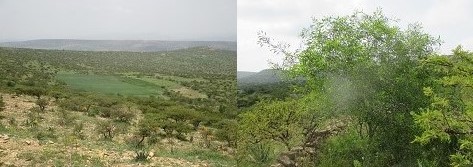Home > International Partnerships > Collaborative Research > Investigation of Symbiotic Microorganisms for Acacia saligna and Agroforestry Applications in Ethiopia
Update:July 20, 2021
Main content starts here.
Investigation of Symbiotic Microorganisms for Acacia saligna and Agroforestry Applications in Ethiopia

1. Partners
Mekelle University, Ethiopia
2. Research Period
FY 2018-2020 Grant-in-Aid for Scientific Research (KAKENHI)
3. Lead Researcher
KAYAMA, Masazumi (Department of Plant Ecology)
4. Background
In the Tigray region of Ethiopia, semi-arid shrubland has a wide distribution, dominated by Acacia etbaica and farmland. In many African countries, agroforestry methods of simultaneously planting trees and cultivating crops are increasingly spreading. For instance, poaceous crops (e.g. barley and sorghum) are often cultivated alongside Faidherbia albida or Acacia saligna trees. Using this method, arbuscular mycorrhizal fungi living in symbiosis with the roots of the tree extend to the crop roots; increasing their yields through synergistic effects. In the Tigray region, an agroforestry to cultivate barley using Faidherbia albida has been conducted. The agroforestry for legume cultivation - an important crop in Ethiopia - was not brought to effect. It was expected to establish the method of agroforestry for legume crops with tree species in Ethiopia for sustainable high yield. Recently, several researches were reported that Acacia saligna could infect various kinds of rhizobium species.
5. Research Goal
The objective of this research is the establishment of a suitable agroforestry technology for enhanced growth of Acacia species and increased crop yield. This technology is based on the symbiotic relationship between soil microorganisms, Acacia trees and crops. Moreover, we also aimed to develop a climate change mitigation technology through the accumulation of carbon fixation.
6. Research Strategy
This research conducts an agroforestry experiment, growing Acacia trees with dominant crops together in the Tigray region of northern Ethiopia. At first, we investigated arbuscular mycorrhizal fungi and rhizobium known to colonize the roots of Acacia and selected suitable species for agroforestry. After this, we decided to select Acacia saligna for the experiment of agroforestry. We plant Acacia saligna seedlings at the site of the experiment, and start cultivating crops of Poaceae and Fabaceae species on the same site. We then examine the tree growth and crop yield.
7. Scientific Achievement
We sowed seeds of wheat, barley, and grass pea in several blocks of the Agroforestry test site in Kihen Village, Tigray, where A. saligna was planted. There was very little growth of wheat, but we were able to obtain the data on the above-ground biomass of barley and grass pea. We found a positive correlation between the above-ground biomass of grass pea beans and the tree density of A. saligna, and the biomass of grass pea was particularly large in blocks with high density of A. saligna. The planting of A. saligna may have increased the nutrients in the soil, particularly so for nitrogen, and might have increased the grass pea biomass. Though we found a similar trend for barley, the relationship between the barley biomass and the density of planting of A. saligna was not significant. In connection with agroforestry research, we also studied the enhancement of symbiotic relationships with microorganisms by using charcoal and the effect of promoting tree growth. For acacia (A. etbaica, F. albida), and indigenous tree species (Olea europaea subsp. cuspidata and Dodonaea angustifolia), we added 1 kg of charcoal (A. etbaica) and planted their seedlings. The addition of charcoal increased the leaf dry mass of A. etbaica and the leaf and root dry masses of F. albida. The nitrogen concentration in the leaves of F. albida increased with the addition of charcoal, and the nitrogen fixation capacity arising from the action of rhizobia might increase with the addition of charcoal. The addition of charcoal was not accompanied by increases in the concentrations of other nutrients in acacias; however, the total contents of nutrients (nutrient concentration x dry weight) in the leaves of both tree species increased with the addition of charcoal. O. europaea subsp. cuspidata and D. angustifolia did not exhibit accelerated growth following the addition of charcoal. However, the addition of charcoal increased the rate of colonization by arbuscular mycorrhizal fungi and the concentrations of nitrogen and calcium in the roots.
8. Applications
As regards the use of charcoal when planting seedlings, we introduced the effects of charcoal in promoting the growth of acacia species at a stakeholder meeting held in Tigray (June 1–2 2019, Mekelle University, Tigray Agricultural and Rural Development Bureau, Kilte Awulaelo Agricultural office).
9. Publications
Kayama, M., Takenaka, K., Abebe, B., Birhane, E. (2019) Effects of biochar on the growth of Olea europaea subsp. cuspidata and Dodonaea angustifolia planted in Tigray, northern Ethiopia. J. Jpn. Soc. Reveget. Tech. 45: 115-120.
Kayama, M., Takenaka, K., Koda, K., Sakai, T., Oniki, S., Hirata, M., Ogawa, R., Abebe, B. Girmay, G., Berhe, M., Gebreanenia, B., Birhane, E. (2019) The conservation of the forest of Acacia etbaica located in Tigray region, northern Ethiopia for the sustainable utilization. XXV IUFRO World Congress Forest Research and Cooperation for Sustainable Development, Abstract: 633
Kayama, M., Sakai, T., Abebe, B., Birhane, E. Factor of habitat for the growth of Acacia etbaica grown in Tigray region, northern Ethiopia. Abstract of 64th annual meeting of the Ecological Society of Japan, March 2020.
Kayama, M., Abebe, B., Birhane, E. (2021) Effects of biochar on the growth of Vachellia etbaica and Faidherbia albida planted in Tigray, northern Ethiopia. Japan Agricultural Research Quarterly 55 (in press).
Copyright © Forest Research and Management Organization. All rights reserved.
